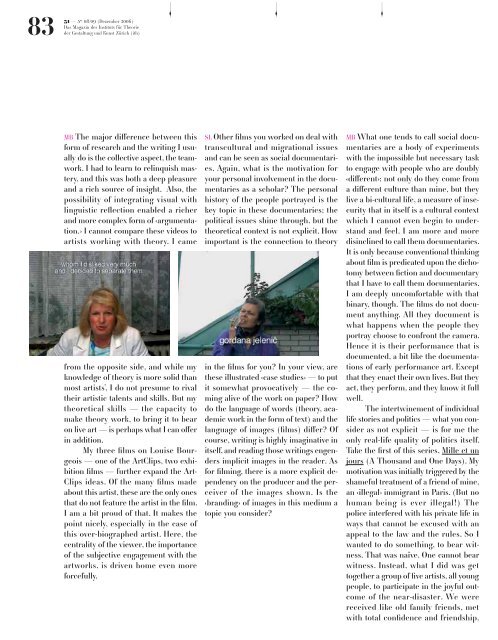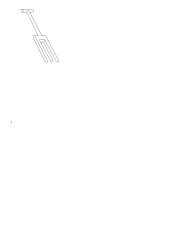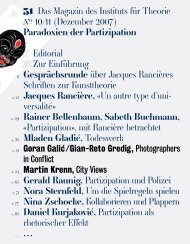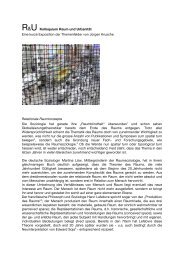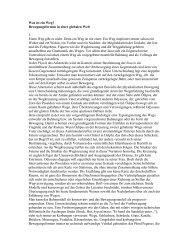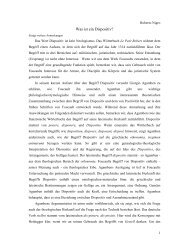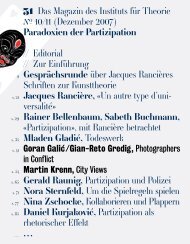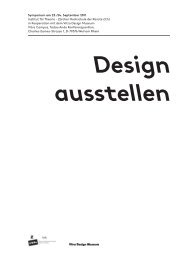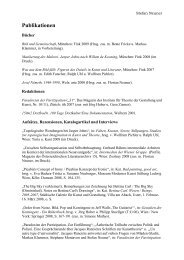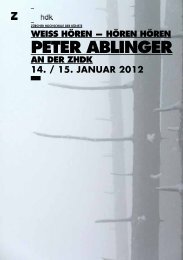PDF des gesamten Heftes (5MB) - Institut für Theorie ith
PDF des gesamten Heftes (5MB) - Institut für Theorie ith
PDF des gesamten Heftes (5MB) - Institut für Theorie ith
Sie wollen auch ein ePaper? Erhöhen Sie die Reichweite Ihrer Titel.
YUMPU macht aus Druck-PDFs automatisch weboptimierte ePaper, die Google liebt.
83<br />
31 — # 08/09 (Dezember 2006)<br />
Das Magazin <strong>des</strong> <strong>Institut</strong>s <strong>für</strong> <strong>Theorie</strong><br />
der Gestaltung und Kunst Zürich (<strong>ith</strong>)<br />
_–<br />
_–<br />
_–<br />
MB The major difference between this<br />
form of research and the writing I usually<br />
do is the collective aspect, the teamwork.<br />
I had to learn to relinquish mastery,<br />
and this was both a deep pleasure<br />
and a rich source of insight. Also, the<br />
possibility of integrating visual w<strong>ith</strong><br />
linguistic reflection enabled a richer<br />
and more complex form of ‹argumentation.›<br />
I cannot compare these videos to<br />
artists working w<strong>ith</strong> theory. I came<br />
from the opposite side, and while my<br />
knowledge of theory is more solid than<br />
most artists’, I do not presume to rival<br />
their artistic talents and skills. But my<br />
theoretical skills — the capacity to<br />
make theory work, to bring it to bear<br />
on live art — is perhaps what I can offer<br />
in addition.<br />
My three films on Louise Bourgeois<br />
— one of the ArtClips, two exhibition<br />
films — further expand the Art-<br />
Clips ideas. Of the many films made<br />
about this artist, these are the only ones<br />
that do not feature the artist in the film.<br />
I am a bit proud of that. It makes the<br />
point nicely, especially in the case of<br />
this over-biographed artist. Here, the<br />
centrality of the viewer, the importance<br />
of the subjective engagement w<strong>ith</strong> the<br />
artworks, is driven home even more<br />
forcefully.<br />
SL Other films you worked on deal w<strong>ith</strong><br />
transcultural and migrational issues<br />
and can be seen as social documentaries.<br />
Again, what is the motivation for<br />
your personal involvement in the documentaries<br />
as a scholar? The personal<br />
history of the people portrayed is the<br />
key topic in these documentaries; the<br />
political issues shine through, but the<br />
theoretical context is not explicit. How<br />
important is the connection to theory<br />
in the films for you? In your view, are<br />
these illustrated ‹case studies› — to put<br />
it somewhat provocatively — the coming<br />
alive of the work on paper? How<br />
do the language of words (theory, academic<br />
work in the form of text) and the<br />
language of images (films) differ? Of<br />
course, writing is highly imaginative in<br />
itself, and reading those writings engenders<br />
implicit images in the reader. As<br />
for filming, there is a more explicit dependency<br />
on the producer and the perceiver<br />
of the images shown. Is the<br />
‹branding› of images in this medium a<br />
topic you consider?<br />
MB What one tends to call social documentaries<br />
are a body of experiments<br />
w<strong>ith</strong> the impossible but necessary task<br />
to engage w<strong>ith</strong> people who are doubly<br />
‹different›: not only do they come from<br />
a different culture than mine, but they<br />
live a bi-cultural life, a measure of insecurity<br />
that in itself is a cultural context<br />
which I cannot even begin to understand<br />
and feel. I am more and more<br />
disinclined to call them documentaries.<br />
It is only because conventional thinking<br />
about film is predicated upon the dichotomy<br />
between fiction and documentary<br />
that I have to call them documentaries.<br />
I am deeply uncomfortable w<strong>ith</strong> that<br />
binary, though. The films do not document<br />
anything. All they document is<br />
what happens when the people they<br />
portray choose to confront the camera.<br />
Hence it is their performance that is<br />
documented, a bit like the documentations<br />
of early performance art. Except<br />
that they enact their own lives. But they<br />
act, they perform, and they know it full<br />
well.<br />
The intertwinement of individual<br />
life stories and politics — what you consider<br />
as not explicit — is for me the<br />
only real-life quality of politics itself.<br />
Take the first of this series, Mille et un<br />
jours (A Thousand and One Days). My<br />
motivation was initially triggered by the<br />
shameful treatment of a friend of mine,<br />
an ‹illegal› immigrant in Paris. (But no<br />
human being is ever illegal!) The<br />
police interfered w<strong>ith</strong> his private life in<br />
ways that cannot be excused w<strong>ith</strong> an<br />
appeal to the law and the rules. So I<br />
wanted to do something, to bear witness.<br />
That was naïve. One cannot bear<br />
witness. Instead, what I did was get<br />
together a group of five artists, all young<br />
people, to participate in the joyful outcome<br />
of the near-disaster. We were<br />
received like old family friends, met<br />
w<strong>ith</strong> total confidence and friendship,


